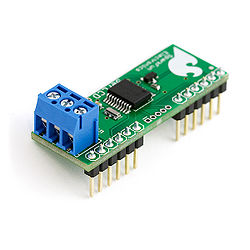Serial enabled LCD backpack: Difference between revisions
m corrected small issue |
→Code: added functions |
||
| Line 57: | Line 57: | ||
=== Code === | === Code === | ||
{{expand section}} | {{expand section}} | ||
<pre> | |||
<source lang="C"> | |||
//SerialLCD Functions | |||
void selectLine(int line) { | |||
serCommand(); //command flag | |||
switch( line ){ | |||
case 0: | |||
lcd.print(128,BYTE); //puts the cursor at line 0 char 0 | |||
break; | |||
case 1: | |||
lcd.print(192,BYTE); //puts the cursor at line 0 char 0 | |||
break; | |||
case 2: | |||
lcd.print(148,BYTE); //puts the cursor at line 0 char 0 | |||
break; | |||
case 3: | |||
lcd.print(212,BYTE); //puts the cursor at line 0 char 0 | |||
break; | |||
default: | |||
selectLine(0); //defaults back to line 0 | |||
break; | |||
} | |||
} | |||
void goTo(int position) { //position = line 1: 0-19, line 2: 20-39, etc, 79+ defaults back to 0 | |||
if (position<20){ Serial.print(0xFE, BYTE); //command flag | |||
Serial.print((position+128), BYTE); //position | |||
}else if (position<40){Serial.print(0xFE, BYTE); //command flag | |||
Serial.print((position+128+64-20), BYTE); //position | |||
}else if (position<60){Serial.print(0xFE, BYTE); //command flag | |||
Serial.print((position+128+20-40), BYTE); //position | |||
}else if (position<80){Serial.print(0xFE, BYTE); //command flag | |||
Serial.print((position+128+84-60), BYTE); //position | |||
} else { goTo(0); } | |||
} | |||
void clearLCD(){ | |||
Serial.print(0xFE, BYTE); //command flag | |||
Serial.print(0x01, BYTE); //clear command. | |||
} | |||
void backlightOn(){ //turns on the backlight | |||
Serial.print(0x7C, BYTE); //command flag for backlight stuff | |||
Serial.print(157, BYTE); //light level. | |||
} | |||
void backlightOff(){ //turns off the backlight | |||
Serial.print(0x7C, BYTE); //command flag for backlight stuff | |||
Serial.print(128, BYTE); //light level for off. | |||
} | |||
void backlight50(){ //sets the backlight at 50% brightness | |||
Serial.print(0x7C, BYTE); //command flag for backlight stuff | |||
Serial.print(143, BYTE); //light level for off. | |||
} | |||
void serCommand(){ //a general function to call the command flag for issuing all other commands | |||
Serial.print(0xFE, BYTE); | |||
} | |||
</source> | |||
</pre> | |||
== See also == | == See also == | ||
Revision as of 19:51, 20 January 2010
The Serial Enabled LCD Backpack (SerLCD) is a product made by Sparkfun that allows control of a parallel based LCD over a single-wire serial interface. The SerLCD backpack takes care of all the HD44780 commands allowing seamless integration with any digital device that can communicate via a TTL serial line. The device is designed to handle a wide range of TTL serial baud rates, and currently supports 16 or 20 character wide screens with 2 or 4 lines of display.
| Serial Enabled LCD Backpack (SerLCD) | |
|---|---|

A version 2 backpack. | |
| General Information | |
| Manufacturer | SparkFun Electronics |
| Current Version | 2.5 |
| Average Price | $17 |
| Specifications | |
| Input Voltage | 5 V |
| Max Input Voltage | 5.5 V |
| Current Draw | 3 mA w/o backlight 60mA w/ backlight |
| Clock Speed | 8 MHz |
| Number of Positions | 16 |
| Measurements | |
| Length | 1.75 inches |
| Width | 0.56 inches |
Communication
Communication with SerLCD requires 5V TTL serial at a default baud rate of 9600bps with 8 bits of data, 1 start bit, 1 stop bit, and no parity (8-N-1). You can adjust the baud to any standard rate between 2400 and 38400bps. The power, ground and RX pins are all broken out to a 3.5mm pitch screw terminal.
Pinout
- Ground (VSS)
- +5V (VDD)
- Contrast adjustment (V0)
- High/Low Register select signal (RS)
- High/Low Read/Write signal (R/W)
- High/Low Enable signal (E)
- High/Low bus line (DB0)
- High/Low bus line (DB1)
- High/Low bus line (DB2)
- High/Low bus line (DB3)
- High/Low bus line (DB4)
- High/Low bus line (DB5)
- High/Low bus line (DB6)
- High/Low bus line (DB7)
- +4.2V for LED (A)
- Power supply for BKL 0V (K)
Features
- New PIC 16F688 utilizes onboard UART for greater communication accuracy
- Adjustable baud rates of 2400, 4800, 9600 (default), 14400, 19200 and 38400
- Operational Backspace
- Greater processing speed at 10MHz
- Incoming buffer stores up to 80 characters
- Backlight transistor can handle up to 1A
- Pulse width modulation of backlight allows direct control of backlight brightness and current consumption
- Potentiometer to control contrast
- All surface mount design allows a backpack that is half the size of the original
- Faster boot-up time
- Boot-up display can be turned on/off via firmware
- User definable splash screen
Arduino
SerLCD works seamlessly with the Arduino with the option of using the default serial transmission port, or by creating a SoftwareSerial port.
Code
|
|
This section requires expansion. |
<source lang="C">
//SerialLCD Functions
void selectLine(int line) {
serCommand(); //command flag
switch( line ){
case 0:
lcd.print(128,BYTE); //puts the cursor at line 0 char 0
break;
case 1:
lcd.print(192,BYTE); //puts the cursor at line 0 char 0
break;
case 2:
lcd.print(148,BYTE); //puts the cursor at line 0 char 0
break;
case 3:
lcd.print(212,BYTE); //puts the cursor at line 0 char 0
break;
default:
selectLine(0); //defaults back to line 0
break;
}
}
void goTo(int position) { //position = line 1: 0-19, line 2: 20-39, etc, 79+ defaults back to 0
if (position<20){ Serial.print(0xFE, BYTE); //command flag
Serial.print((position+128), BYTE); //position
}else if (position<40){Serial.print(0xFE, BYTE); //command flag
Serial.print((position+128+64-20), BYTE); //position
}else if (position<60){Serial.print(0xFE, BYTE); //command flag
Serial.print((position+128+20-40), BYTE); //position
}else if (position<80){Serial.print(0xFE, BYTE); //command flag
Serial.print((position+128+84-60), BYTE); //position
} else { goTo(0); }
}
void clearLCD(){
Serial.print(0xFE, BYTE); //command flag
Serial.print(0x01, BYTE); //clear command.
}
void backlightOn(){ //turns on the backlight
Serial.print(0x7C, BYTE); //command flag for backlight stuff
Serial.print(157, BYTE); //light level.
}
void backlightOff(){ //turns off the backlight
Serial.print(0x7C, BYTE); //command flag for backlight stuff
Serial.print(128, BYTE); //light level for off.
}
void backlight50(){ //sets the backlight at 50% brightness
Serial.print(0x7C, BYTE); //command flag for backlight stuff
Serial.print(143, BYTE); //light level for off.
}
void serCommand(){ //a general function to call the command flag for issuing all other commands
Serial.print(0xFE, BYTE);
}
</source>
See also
